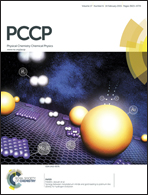Synergy between molybdenum nitride and gold leading to platinum-like activity for hydrogen evolution†
Abstract
Reduced size and direct electrochemical H2 compression are two distinct advantages of electrolyzers based on the acid–polymer electrolyte membrane technology over those relying on alkaline electrolytes. However, recourse to catalysts based on the scarce platinum-group-metals has hitherto been the price to pay. While the transition metal sulfides and nitrides of group VI have recently shown interesting activities for H2 evolution, the remaining activity gap with Pt needs to be reduced. Platinum owes its high activity to its optimum metal–hydrogen bond strength for H2 evolution, which is a proven descriptor of the activity on single-component catalysts. Here, we unravel a major synergetic effect between gold and molybdenum nitride which multiplies the hydrogen evolution activity ca. 100 times over that of either gold or molybdenum nitride. This two-phase catalytic material, featuring both strong and weak metal–hydrogen bonds, overcomes the limitations described by Sabatier's principle for single-component catalysts.


 Please wait while we load your content...
Please wait while we load your content...